Professional bike fits are undeniably valuable, but let’s face it, they can be a significant investment and sometimes just plain inconvenient. If you’re looking for a more accessible way to dial in your bike fit, or simply want to understand what size bike you need, you’re in luck. The internet is awash with online bike fit calculators designed to help riders like you achieve a comfortable and efficient riding position from the comfort of your home. These tools range from basic Bike Size Calculators, perfect for initial guidance, to more sophisticated fit calculators that aim to mimic the insights of a professional in-person bike fit. But with so many options available, how do you discern which bike size calculators are genuinely helpful and which are, well, just not? I’ve put some of the most popular calculators to the test to bring you the answers.
Shop Bikes
Top Bike Sizing & Fit Calculators: My Recommendations
- Best Comprehensive Bike Fit Calculator: Wrench Science Fit System
For riders primarily focused on determining the correct bike size for purchase, or needing a reliable starting point for setting saddle height on a new bike, the Specialized / Retül app, accessible through the Specialized website, stood out as the most accurate in my testing.
However, if your goal extends to more granular adjustments of your riding position – encompassing aspects like frame stack and reach, saddle setback, stem length, handlebar width, and saddle-to-bar drop – the Fit System calculator from Wrench Science proved to be exceptionally user-friendly, delivering the most lucid and practical recommendations.
Keep reading to delve deeper into the rationale behind these selections.
The Best Basic Bike Frame Size Calculator Options
For those newer to cycling, navigating bike sizing can feel overwhelming, particularly when shopping online and the option to test-ride a bike isn’t readily available.
Thankfully, numerous basic bike size calculators are readily accessible online. The majority rely on your height, some incorporate inseam measurements, and others utilize both. While I encountered several serviceable calculators, a recurring theme was the tendency for many to suggest bike sizes that I perceived as either too small or too large. It’s crucial to approach the results from any basic online sizing calculator with a degree of skepticism.
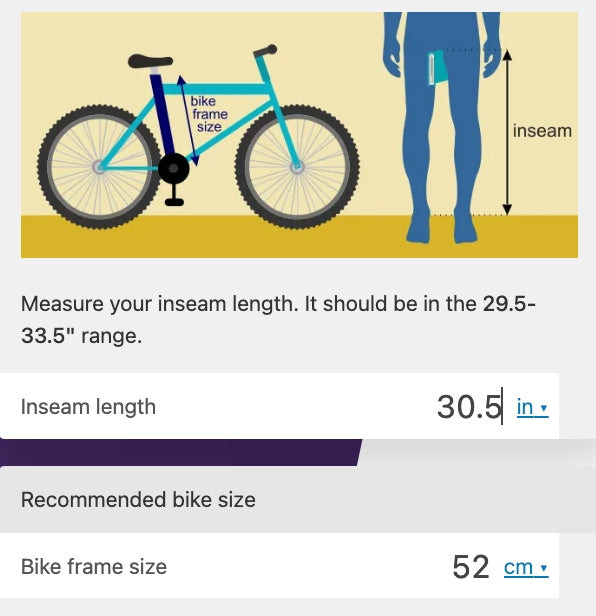 Omni bike fit calculator
Omni bike fit calculator
One fundamental bike size calculator that yielded commendable results (at least for my measurements) is the Omni Calculator. It provides clear instructions on accurately measuring your inseam (it’s important to note that your true inseam differs from your pant inseam). The calculator’s recommendation aligned with my current frame size. Importantly, it also presents alternative frame size options that could be viable. This is a key consideration because most cyclists can comfortably ride across a range of bike frame sizes, and sizing nuances can vary between manufacturers.
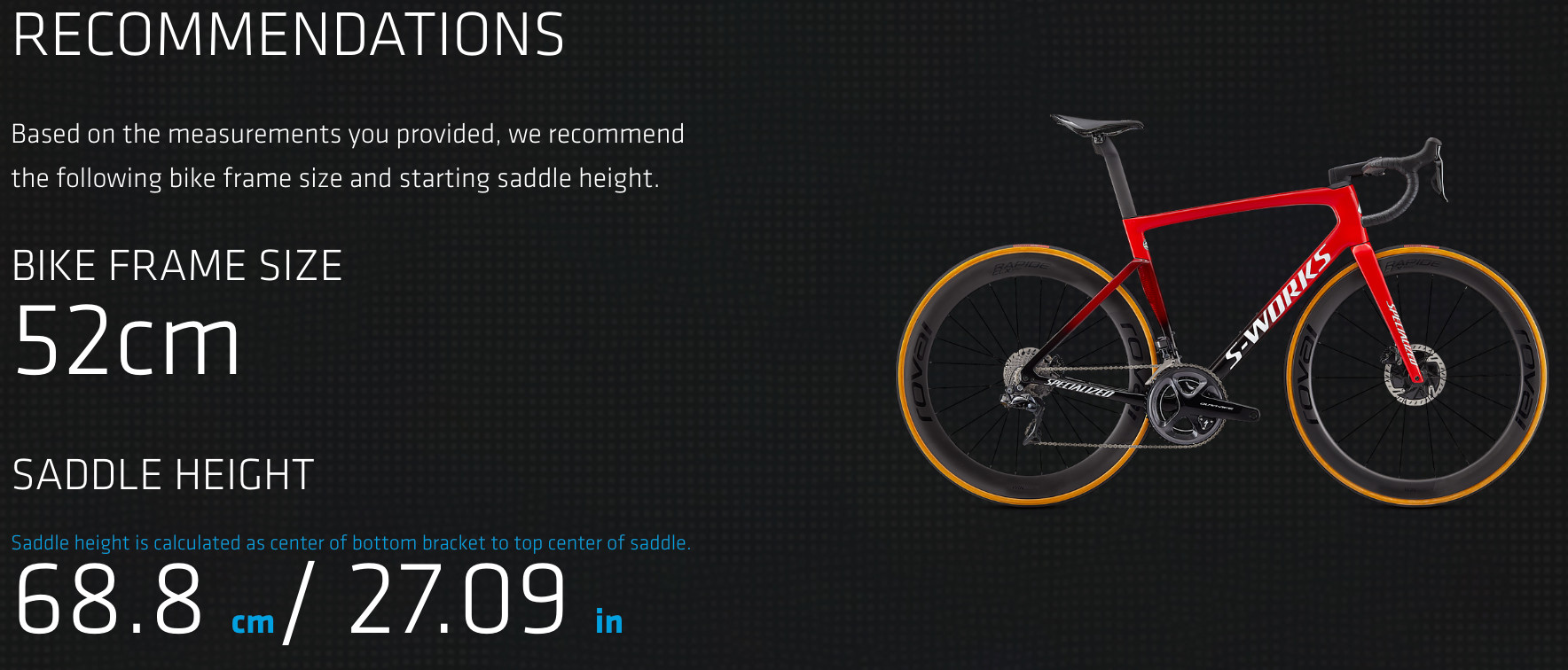 Specialized Retul bike size calculator
Specialized Retul bike size calculator
Initially, Omni was my leading recommendation until I explored the Retül Fit App on the Specialized website. Unlike many other bike size calculators, Retül’s app utilizes both your height and shin length (with clear guidance on how to measure your shin within the app). Retül leverages a vast dataset of fit information gathered from tens of thousands of cyclists globally. By inputting just your height and shin length, it can estimate your optimal frame size and saddle height with surprising accuracy.
For me, the results were remarkably precise. It not only recommended my usual frame size but, even more impressively, provided a saddle height measurement within mere millimeters of the setting my Retül fitter established during my last professional bike fit session. This level of accuracy significantly boosts my confidence in this tool.
However, a couple of caveats are worth noting: the suggested frame size is tailored for Specialized road/gravel bikes, and sizing conventions can differ across brands, so keep this in mind. Also, the saddle height recommendation is intended as a starting point. You’ll likely need to fine-tune it slightly higher or lower after some test rides. Ensure you meticulously follow the instructions and measure your shin length accurately, as even a half-inch discrepancy can noticeably alter the results.
Finding a More Detailed Online Bike Fit Calculator
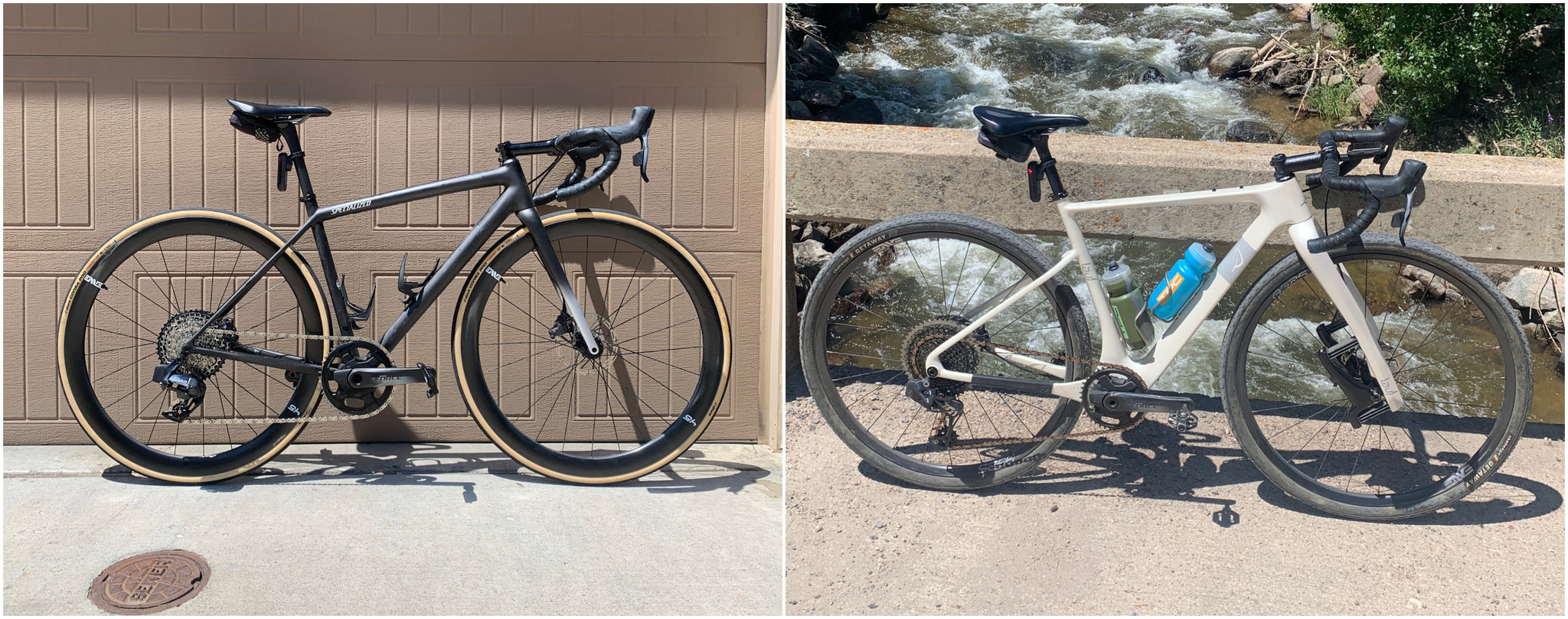 Best bike fit calculator
Best bike fit calculator
If you’re becoming more dedicated to cycling, investing in a professional bike fit is among the most impactful steps you can take. It goes beyond merely selecting the right frame size or setting your saddle height. A qualified professional bike fitter will meticulously adjust your contact points (saddle, handlebars, pedals) and your overall riding posture to maximize comfort and efficiency. This proactive approach can also play a crucial role in preventing injuries or accommodating pre-existing conditions.
For years, my trusted resource for bike fitting has been Retül. I consider them a leader in the field, but the cost can range from $300 to $500, depending on the fitter’s expertise and any supplementary components (such as saddles, stems, or handlebars) needed post-fit. Consequently, professional bike fits aren’t universally accessible due to cost or time constraints.
This is where online bike fit calculators offer a valuable alternative. While no online tool can replicate the precision and personalized insights of an in-person bike fit, they serve as an excellent starting point for riders to refine their bike fit independently at home.
Here’s an evaluation of three prominent online bike fit calculators that I tested:
It’s worth noting that these are competitors of TPC. As we don’t offer a similar service, these were the available resources for this evaluation.
These calculators generally utilize similar measurements to determine bike fit: height, sternal notch, inseam, torso length, upper and lower arm lengths, and upper and lower leg lengths. They also incorporate options to specify your desired riding style, ranging from aggressively race-oriented to comfortably upright.
My assessments of these calculators are grounded in how closely their recommendations aligned with my real-world road and gravel bikes and their established fits, all meticulously fine-tuned over 15 years and further refined with the expertise of a Retül professional bike fitter.
Here’s a summary of my key fit parameters following my last Retül session:
| Height | 5’ 8.5” |
|---|---|
| Inseam | 30.5” |
| Current nominal bike size | 52cm / Small |
| Current ETT (Effective Top Tube) | 531mm (road) / 544mm (gravel) |
| Current reach | 380mm / 383mm |
| Current stack | 527mm / 537mm |
| Stem length | 120mm |
| Bar width | 400mm |
| Saddle height | 691mm |
| Saddle setback | 72mm |
| Saddle-to-bar drop | 91mm / 84mm |
| Cockpit length | 560mm /555mm |
Top Pick: The Wrench Science Fit System Calculator
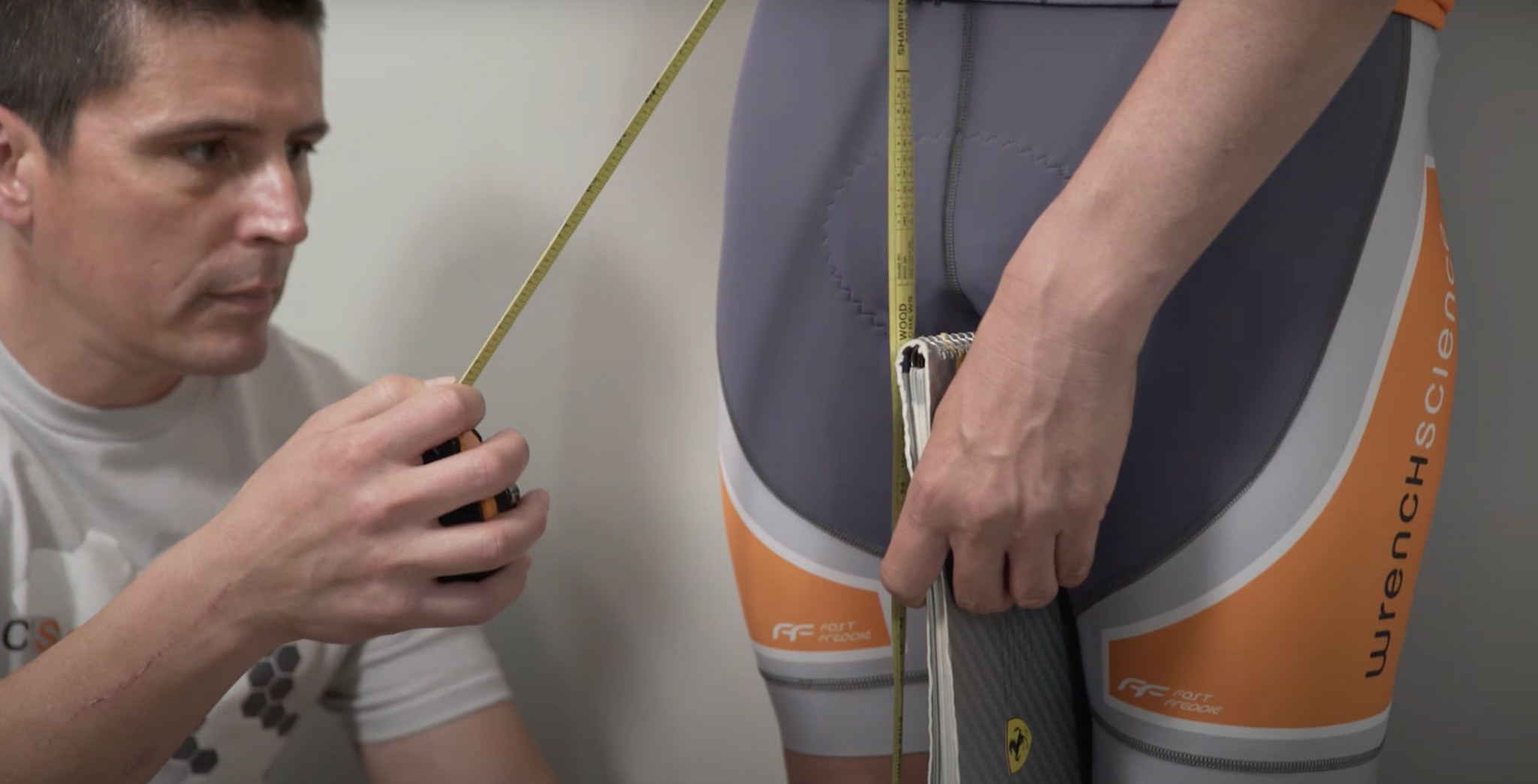 Wrench Science bike fit measuring
Wrench Science bike fit measuring
Wrench Science emerges as my top recommendation for an online bike fit calculator, and there are several compelling reasons why. Firstly, it uniquely incorporates shoulder width and, crucially, flexibility measurements (easily assessed using their provided flexibility chart) to enhance the precision of its recommendations.
I also greatly appreciated Wrench Science’s inclusion of video tutorials demonstrating the correct method for taking each measurement. Accurate measurement is the most challenging aspect of utilizing any of these calculators, and I found the instructions from Competitive Cyclist and Jenson to be occasionally ambiguous or perplexing. I strongly advise enlisting someone to assist you with measurements; it significantly simplifies the process and improves accuracy. The Wrench Science calculator also allows for decimal input for your measurements, adding another layer of precision.
Ultimately, the accuracy of the results is paramount. Wrench Science earned my top spot because it generated recommendations that most closely mirrored my existing road and gravel bike fits.
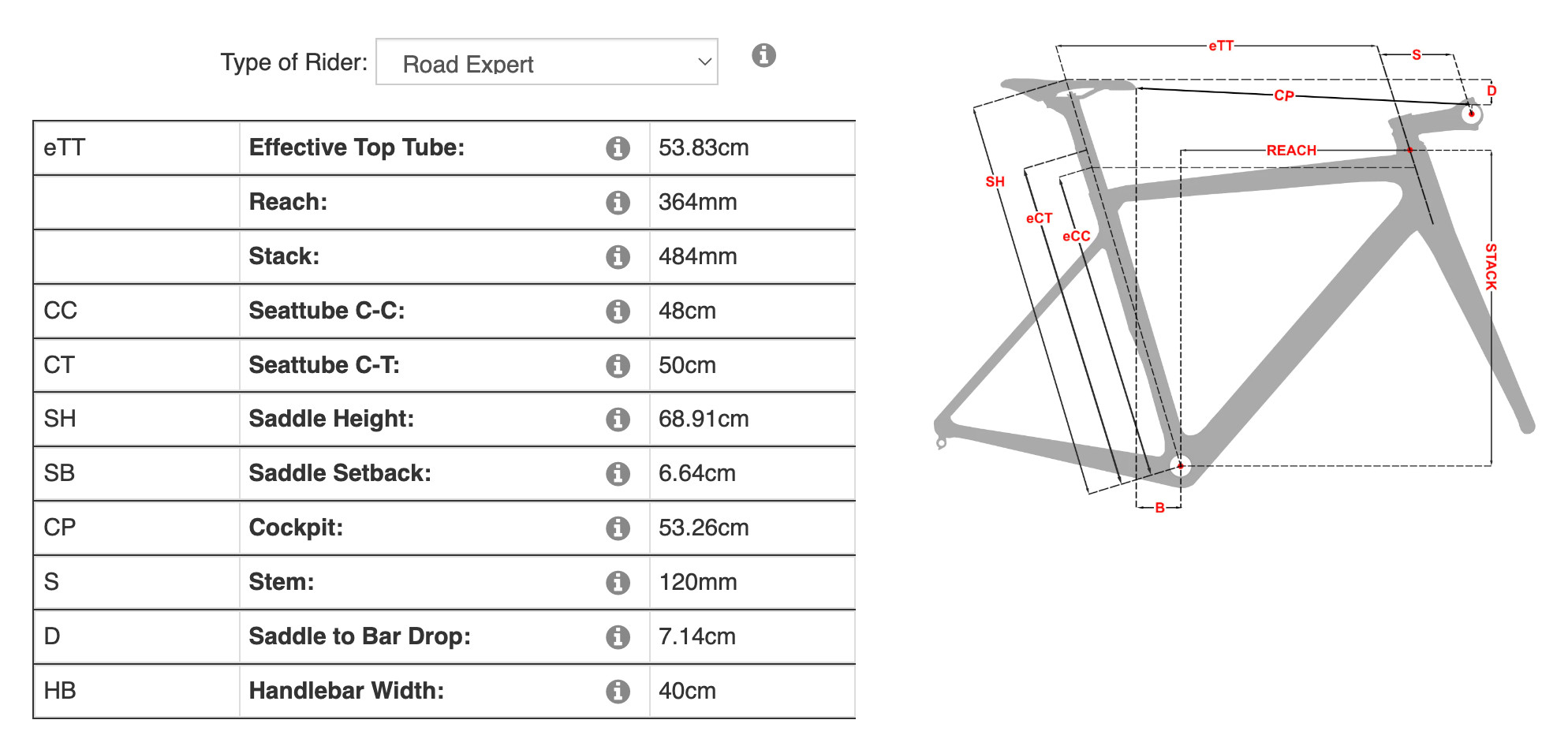 Wrench Science Bike fit calculator
Wrench Science Bike fit calculator
Here’s a breakdown of what the Wrench Science calculator accurately predicted:
- Top tube length
- Saddle height
- Saddle setback
- Stem length
- Bar width
All these measurements were either spot-on or within 10mm of my current bike and fit specifications. It was the only calculator to suggest an effective top tube length and stem length that closely aligned with my actual bike setup. The saddle height and setback recommendations were also impressively accurate.
Areas where the Wrench Science calculator fell short, in my assessment:
- Frame stack
- Frame reach
- Cockpit length (saddle tip to bars)
- Saddle to bar drop
Among these, the frame stack recommendation was the most significant deviation. It suggested a frame with a 484mm stack height, which is impractically low. My current road frame has a stack height of 527mm, and I could likely only comfortably reduce it by 10-15mm. In fact, I’m uncertain if any bike in my size exists with such a low stack height, and even if it did, it wouldn’t be a comfortable ride for me. Despite re-measuring and re-testing the calculator multiple times, using both inches and centimeters, the stack height recommendation appears to be an anomaly within the Wrench Science calculator, so I would advise disregarding it.
Additionally, while it correctly identified my stem length, the suggested frame reach is almost 20mm shorter than both of my current bikes, hence my classification as a “miss.” Regarding saddle-to-bar drop, while technically different from my setup, I believe it’s likely a suitable recommendation for riders who prefer a less aggressive, more upright cockpit.
Runner-Up: Competitive Cyclist Fit Calculator
 Competitive Cyclist fit calculator
Competitive Cyclist fit calculator
Among the three calculators evaluated, the Competitive Cyclist’s fit calculator is arguably the most established and frequently referenced. It has been available for at least 15 years, and I recall using it myself back in 2007 to set up my road bike. To the best of my knowledge, it has remained largely unchanged since then, which might be a disadvantage in terms of incorporating modern bike fit principles.
The most frustrating aspect of this calculator is its inability to accept decimal inputs. For crucial measurements like inseam, this forces awkward rounding decisions, potentially impacting accuracy. For instance, saddle height calculations were noticeably off. Rounding up resulted in a height that felt too high, while rounding down yielded a height that felt too low.
The calculator also recommended a frame and stem combination that was significantly shorter than my current setup. This discrepancy likely arises because the calculator doesn’t account for flexibility as comprehensively as Wrench Science. I possess good hip mobility and hamstring flexibility and have ridden in long and low positions for over a decade.
If I lacked my current level of flexibility, the shorter frame and stem recommended by Competitive Cyclist might indeed feel more comfortable. In fact, after taking several months off cycling following the birth of my son, I temporarily shortened my stem by 10mm due to reduced flexibility (and some weight gain). This suggests its recommendations might be more relevant for riders with less flexibility or those seeking a more upright and comfortable riding posture.
Another observation, perhaps less relevant to recreational riders, is that the “Competitive” fit option suggested a saddle setback that technically violates UCI regulations (50mm is the minimum legal setback).
Last Place: Jenson Bike Fit Calculator
 Jenson bike fit calculator
Jenson bike fit calculator
As for Jenson’s calculator, it was wildly inaccurate across nearly every measurement. The recommended top tube length and saddle height were both excessively large, particularly considering it also suggested a much smaller 50cm frame size (I typically ride a 52-54cm) paired with a 90mm stem, a combination that defied logic.
Despite repeated re-measurements and tests, switching between inches and centimeters, each attempt yielded results that were simply incorrect. Overall, the outcomes from Jenson’s calculator were perplexing, and I would not recommend using it.
Final Thoughts
Based on my personal testing, the Wrench Science Fit System stands out as the most effective free online bike fitting tool available. It’s user-friendly and delivers reasonably accurate results. However, it’s important to acknowledge the limitation that I represent a sample size of one. Riders with different body proportions and riding preferences may experience varying outcomes.
I have above-average flexibility and prefer a low and aggressive riding position. I suspect that both the Wrench Science and Competitive Cyclist calculators may be most beneficial for newer or more comfort-oriented riders seeking a slightly more upright fit.
Furthermore, all online bike size calculators inherently overlook several crucial bike fit elements that a professional in-person fitter can address:
- Saddle shape and width
- Saddle tilt
- Q-factor (stance width)
- Crank length
- Cleat position
- Handlebar/shifter hood angle
- Addressing aches and pains
That final point is particularly significant. Consulting with an experienced and knowledgeable fitter who understands human biomechanics can be invaluable if you’re experiencing discomfort or pain while cycling. My bike fitter successfully resolved my knee pain, and I continue to rely on his expertise to maintain a pain-free riding experience.
Ultimately, an online bike fit calculator should be considered a preliminary step, a starting point. Utilize it to establish your initial stem length, handlebar height, and saddle position. As you accumulate more riding experience, you’ll develop a better understanding of the adjustments needed to optimize your comfort and performance.
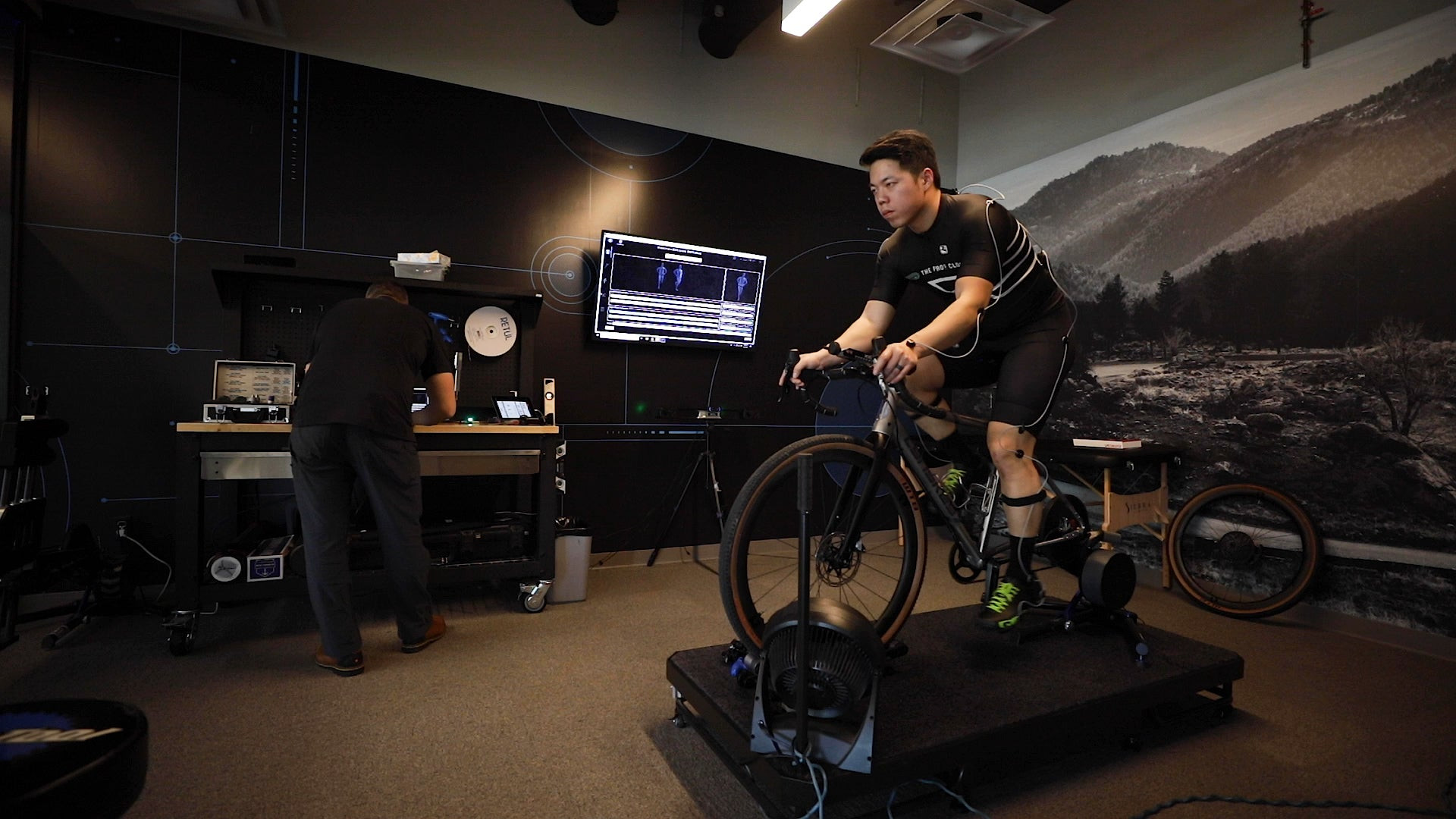 In-person professional bike fits represent the next level of refinement for serious cyclists seeking optimal performance and comfort.
In-person professional bike fits represent the next level of refinement for serious cyclists seeking optimal performance and comfort.
However, if you find yourself consistently struggling to achieve a comfortable bike setup, seeking a professional bike fit is advisable. I personally use Retül due to their motion capture technology and the comprehensive “Fit Report” they provide, enabling consistent fit replication across multiple bikes (my recent Fit Report served as the benchmark for evaluating these online calculators).
Read About My Bike Fit Experience
Keep in mind that numerous qualified fitters offer services at a lower price point than Retül. In reality, any reputable fitter with sufficient experience should be capable of guiding you to a riding position that closely meets your needs. I hope this guide has been helpful. Best of luck fine-tuning your bike fit, and may your rides be filled with countless miles of pain-free cycling!
Shop Bikes

